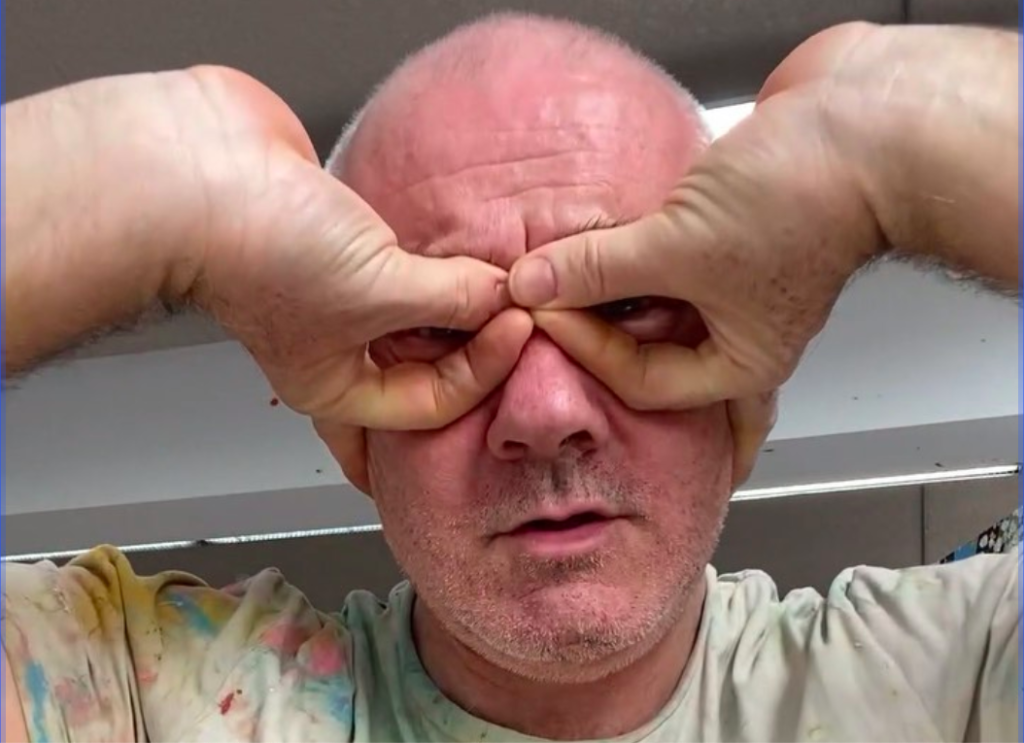Unlike the dead butterflies in his work, Damien Hirst is not easy to pin down.
Everyone wants an interview with the richest living artist, so Hirst decided to kill 98 birds with one stone. In a four-part series on Instagram he has called “On the Psychiatrist’s Couch,” the 54-year-old YBA answers questions submitted by the public about his life, his work, and how he is coping in isolation.
The artist conducts the “self-interview” from his cavernous studio, where he is working on his latest series of cherry-blossom paintings. He explains that he is still driving to and from his studio despite the lockdown in Britain, which technically prohibits anyone but key workers from leaving the house for non-essential purposes.
Nevertheless, the artist says he is taking the coronavirus seriously. “For a while I thought, ‘Maybe I just need to get it, to get it out of the way.’” he says. “But then I thought, ‘I don’t like that lottery.’” As a former heavy smoker, Hirst is among those more vulnerable to the respiratory disease (listen up, David Hockney), so he is wearing masks and gloves in his car on the way to the studio. “I don’t care how stupid I look,” he says.
Interspersed with some banal details of his life such as a penchant for snooker and an obsession with the UFC, the artist gives some insight into the inspirations behind some of his famous works. But we’ve watched all four so you don’t have to. Here are the most interesting tidbits from Hirst’s Insta-confessional.
- A David Cronenberg film inspired Hirst’s “Medicine Cabinet” series. The 1988 film Dead Ringers, which stars Jeremy Irons as identical twin gynecologists, inspired the medicine cabinets, while a rift between his mother and sister was among the trigger points for Mother and Child, Divided, the 1993 work comprising four glass-walled tanks containing the bisected and preserved halves of a cow and calf.
- There’s one material he’s always dreamed of working with: plutonium. We can’t imagine why that’s never happened yet.
- He lives by one particular mantra. “Sometimes you have to step over the edge to know where it is.”
- He’s not as scary as he looks. The former “enfant terrible” of the art world says there is a misconception that he is somehow aggressive. “I’m a softie, really,” he insists. Sometimes, he adds, people are disappointed that he is not more wild, since his early work often came out of drug- and alcohol-fueled binges.
- He treasures his relationship with the late designer Alexander McQueen. Hirst says that when he first met the British designer, he was “mad into cocaine and drinking like a maniac.” Later into the friendship, there was a role reversal, and Hirst says that watching his friend deteriorate was an eye-opener that gave him perspective on what he used to be like.
- He doesn’t drink anymore. Hirst hasn’t touched alcohol for 13 years, and the strongest drink he likes is a cup of rooibos tea—too much caffeine, he says, leads to insomnia.
- He doesn’t believe the art market is a meritocracy. “Loads of amazing artists never get discovered,” Hirst says. He also gives a shout-out to a particular artist he sees as undervalued: Helen Beard, who was included in a 2018 group show at Hirst’s own Newport Street Gallery. Her works can be had for around £5,000 a pop.
- The first time his work sold for £10,000, it “blew [his] mind.” After that, however, the money became somewhat meaningless. He admits that there was a bit of a “slump” in his market around 2010, but says that he doesn’t let the ups and downs get in his head—he just gets on with things.
- He’s not a huge fan of Salvador Dalí. He describes the work of the Surrealist as “hit and miss”—but he loves Francis Bacon because of his “lack of traditional ability.”
- His favorite living artist is fellow YBA Sarah Lucas. “I think it’s because it’s the antithesis of what I do in a lot of ways,” Hirst explains. “Like, I make the diamond skull and she does like two fried eggs and a kebab on a table.”
- He’s got advice for young artists. The main takeaways: “make your paintings bigger,” and “travel as much as you can” to pick the right art school.
- He won’t stick with the bright cherry blossom paintings forever. After a period of focusing on floral, joyful works, Hirst is considering delving into some more dark paintings that he began after a friend died by suicide. “There’s a fear that in dark times art becomes irrelevant,” Hirst says, “but maybe it’s more relevant.”


